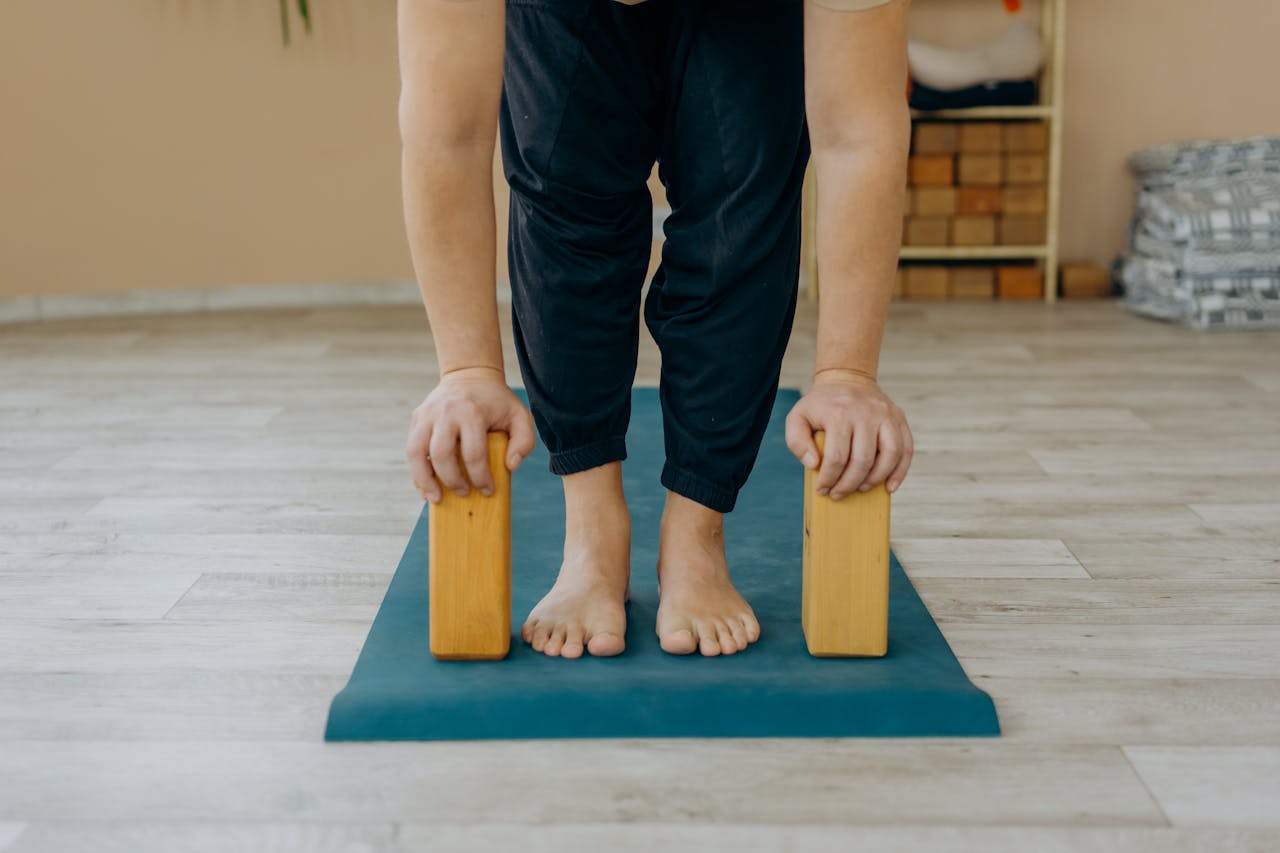
Table of Contents
New and seasoned yoga practitioners can benefit from yoga blocks' support and alignment.
Whether you choose foam or cork blocks, these essential tools can deepen your practice and help you reach challenging poses.
Learn about the various types, sizes, and benefits of yoga blocks, and find the very best yoga block options to suit your needs and elevate your next yoga class.
What are Yoga Blocks
Yoga blocks are supportive tools commonly used in yoga. They are typically made from materials like foam, cork, or wood and come in various sizes and densities.
These blocks are designed to aid in alignment, provide stability, and help in performing certain poses that might be challenging without support.
Whether you're a beginner looking to gain confidence or an experienced yogi wanting to deepen a stretch, yoga blocks can be a valuable addition to your practice.
Foam Yoga Blocks
Lightweight and versatile, foam yoga blocks are suitable for gentle support and are often used in restorative practices. They come in various densities, including soft foam blocks for comfort and high-density foam blocks for firmer support.
Cork Yoga Blocks
Known for their stability and durability, cork yoga blocks provide a solid base for challenging poses. They are eco-friendly and offer slip resistance for a secure grip.
Wooden Blocks
Often made from bamboo or hardwood, these blocks offer a traditional feel and robust support. Wooden blocks are typically heavier and provide a sturdy base.
Bamboo Block
Bamboo blocks are becoming increasingly popular, offering a balance between stability and eco-friendliness.
Recycled EVA Foam Blocks
Recycled EVA foam blocks are known for their durability and resistance to surface-level damage. They are available in different densities and are often used in professional yoga studios.
Benefits of Using Yoga Blocks
Using yoga blocks in your practice can bring many benefits that enhance your physical alignment and overall yoga experience. Here's how:
- Alignment and Balance: Yoga blocks help maintain proper pose alignment, allowing for a deeper stretch and better balance.
- Increased Reach: They can act as an extension of your arms, making poses like forward bends more accessible.
- Support in Restorative Poses: Foam and cork blocks can provide gentle support in restorative poses, allowing muscles to relax.
- Enhanced Strength and Flexibility: By providing support, yoga blocks enable you to hold poses longer, building strength and increasing flexibility.
- Accessibility: Whether tight hamstrings or limited mobility, yoga blocks make challenging poses more attainable, enabling a more inclusive practice.
- Safety: Offering a solid base and good grip, yoga blocks can prevent overstretching and reduce the risk of injury.
Incorporating yoga blocks into your practice, whether foam or other cork yoga blocks, can provide physical support and foster a sense of accomplishment and progression.
From aiding in proper alignment to making challenging poses accessible, these versatile tools can be valuable to beginners and seasoned practitioners.
Who Should Use a Yoga Block?
Yoga blocks are not reserved for any specific group; they can be valuable assets for a wide range of practitioners:
Beginners
If you're new to yoga, blocks can provide support and confidence as you learn and grow.
Experienced Yogis
Even seasoned practitioners can benefit from blocks exploring deeper stretches and challenging poses.
Individuals with Physical Limitations
Whether due to injury or mobility issues, blocks can make yoga more accessible and comfortable.
Teachers and Studios
If you're teaching yoga, having various yoga block types and sizes ensures that students of all levels have the necessary tools.
Eco-Conscious Practitioners
Those seeking sustainable material can opt for cork blocks or recycled foam yoga blocks, aligning their practice with environmental values.
In essence, yoga blocks benefit almost anyone engaged in yoga practice. From beginners looking for support to experienced yogis wanting to explore new depths and even teachers aiming to equip their studios, the versatile nature of yoga blocks makes them a valuable investment for many.
Whether an entire Manduka cork yoga block for sustainability or a soft foam block for gentle support, the right yoga block can enhance your practice in numerous ways.
Yoga Poses With Yoga Blocks
A yoga block can transform your practice by adding support and depth to various poses. Here are some common yoga poses where blocks can be beneficial:
- Triangle Pose: A yoga block under the hand can enhance alignment and ease the strain on the hamstring.
- Bridge Pose: Placing a yoga block under the sacrum can provide support and heighten the stretch in the shoulders and chest.
- Downward Facing Dog: Blocks under the hands can add elevation, relieving pressure on the wrists and shoulders.
- Half Moon Pose: A block under the supporting hand can make this challenging pose more attainable for stability and balance.
- Supported Poses: In restorative yoga, blocks can be used in various ways to provide gentle support and relaxation for the body.
Integrating yoga blocks into these poses allows you to explore new depths in your practice, ensuring proper alignment and making challenging poses more accessible.
The Best Yoga Blocks
Finding the best yoga blocks for your practice depends on your needs, preferences, and budget. Here are some highly recommended options:
- Best Overall: For a balance of quality and price, look for high-density foam blocks with beveled edges for comfort.
- Best Cork Option: Manduka Cork Block offers slip resistance and sustainable material, making it a favorite among many.
- Best for Beginners: Soft foam blocks with rounded edges provide a gentle introduction for those new to yoga.
- Most Eco-Friendly: A recycled foam yoga block or bamboo block emphasize sustainability without sacrificing support.
- Best for Hot Yoga: Opt for blocks with a non-slip surface texture to ensure a good grip during sweaty sessions.
Consider factors like material (foam, cork, or wood), density, Size, and surface texture when choosing the best yoga blocks for your practice.
Yoga Block Sizes
Choosing the right Size of yoga block depends on your needs, body type, and the poses you wish to perform. Here are the standard sizes and their applications:
- Standard Size (9" x 6" x 4"): This Size is versatile and suitable for most yoga practitioners. It offers enough height and support for various poses.
- Small Size (9" x 6" x 3"): A smaller block is ideal for those looking for less support or for use in nuanced adjustments. It's also convenient for travel.
- Large Size (9" x 6" x 5"): For those needing extra height and support, especially in restorative poses, a larger block can be an excellent choice.
- Custom Sizes: Some practitioners prefer customized sizes to suit specific needs or poses. Consulting with a yoga instructor or professional can guide you to the best option.
Consider factors like your flexibility, the types of poses you practice, and your comfort preferences when selecting the block size.
Are Yoga Blocks Worth It?
Whether yoga blocks are worth it, the investment often arises, especially among those new to yoga or contemplating deepening their practice. Here's why many consider most yoga blocks to be well worth it.
Enhanced Alignment
Yoga blocks provide the support needed to maintain proper alignment, reducing the risk of strain or injury.
Increased Accessibility
They make challenging poses more attainable, catering to all levels of flexibility and strength.
Versatility
From foam blocks to cork bricks, yoga blocks come in various types and sizes to suit individual needs, allowing for customization of your practice.
Support in Restorative Yoga
For restorative practice, yoga blocks can add comfort and support, enhancing relaxation.
Longevity
Quality yoga blocks, such as cork or other foam blocks, are durable and can last for many years, making them a cost-effective addition to your yoga props.
Whether aiming for proper alignment, accessibility to certain poses, or added support, investing in yoga blocks is a wise and beneficial decision.
Frequently Asked Questions About Yoga Blocks
What Size should I buy?
Choosing the right Size depends on your specific needs and practice style. Standard Size (9" x 6" x 4") is versatile for most, while smaller or larger sizes may be suited for specific needs or poses.
Consult a certified yoga instructor or try different sizes to find the best fit.
Should I buy 1 or 2 blocks?
While one yoga block can provide ample support, purchasing two blocks offers greater versatility, especially in balancing poses or when different support levels are needed for each side of the body.
Many find having two blocks beneficial for a well-rounded practice.
What is a yoga block good for?
Yoga blocks serve multiple purposes, including aiding alignment, enhancing stability, supporting restorative poses, and making challenging poses accessible.
They are valuable tools for beginners and seasoned practitioners, offering physical support and fostering progression.
How long do yoga blocks last?
The lifespan of yoga blocks depends on the material and usage. Foam yoga blocks can last several years with regular use, while cork and wooden blocks may last even longer with proper care.
Quality materials like EVA foam or a reputable brand like the Manduka block can ensure longevity.
References
What is a Yoga Block? - Definition from Yogapedia
The 5 Best Yoga Blocks for Home Practice
Disclaimer
The contents of this article are provided for informational purposes only and are not intended to substitute for professional medical advice, diagnosis, or treatment. It is always recommended to consult with a qualified healthcare provider before making any health-related changes or if you have any questions or concerns about your health. Anahana is not liable for any errors, omissions, or consequences that may occur from using the information provided.

By: Meriah McCauley
Meriah McCauley is a leading voice in holistic healing, known across North America for her expertise in chakra balancing, spiritual alignment, and energy-based wellness. Her work bridges the art and science of mind-body healing, shaped through years of study, practice, and mentorship. Meriah deepened her understanding of spiritual anatomy and the chakra system under the guidance of her guru, Dr. Don Stapleton, during her immersive training in Costa Rica. She later earned her Master’s degree in Psychology from Columbia University, specializing in Spirituality and the Mind–Body connection, which continues to influence her integrative approach. Today, she supports individuals and practitioners through coaching, yoga teacher trainings, chakra-focused education, and Holotropic Breathwork for personal transformation. Meriah is dedicated to helping others develop emotional clarity, energetic balance, and spiritual resilience—and she remains committed to guiding anyone seeking a deeper, more meaningful connection with themselves.